TYTIA HABING: About a Boy
October 31 – December 1, 2016
Artist Lecture: Wednesday, November 9, 1PM
University of St. Francis Art Gallery
25 East Van Buren
Joliet, IL 60432
The gallery and all events are free and open to the public
Fall gallery hours: Monday + Wednesday: 10am-4pm, Tuesday + Thursday: 10am-2pm
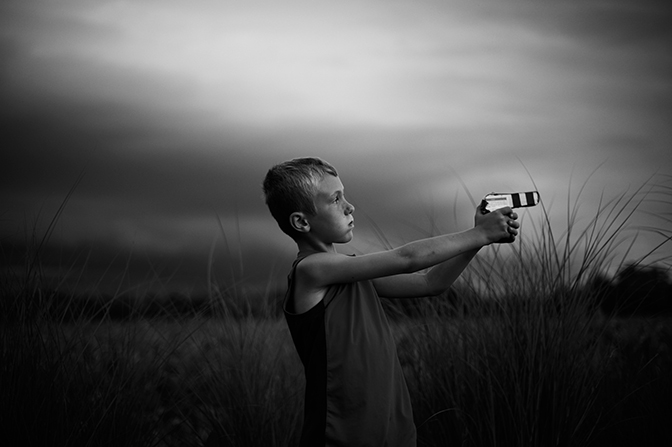
Tytia Habing, Expressing My Aggressions, n.d.
Artist Interview: Tytia Habing (TH) and Jennifer Moore (JM), Gallery Director
JM: You have a BS in Horticulture, a BA in Landscape Architecture and you are a self-taught photographer. Can you tell us a little about how you became interested in photography, how you learned the craft and how what role your degrees play in your image making, if any?
TH: Getting into photography was a happy accident. Even though my older brother graduated with a degree in photography, it was never something I thought I would be interested in. When I was getting my second degree, this time in landscape architecture, I was in my last year and had to find some electives to fill my course load. I found an intro to photography class that was starting in the fall, and it was close to the landscape architecture buildings, so it seemed like a convenient and easy choice. Little did I know, soon after my first darkroom class, I would become completely obsessed with it. I spent every spare minute in the university darkroom and I even went out and bought all my own equipment to set up a little darkroom in my bathroom. I was able to fit the follow up intro to photography course into my schedule in the spring as well, but that was the extent of my education in photography. I’ve learned everything on my own since then. I’ve been shooting now for eighteen years.
I’m not sure my degrees have played a role in my image making. Even if I didn’t have those degrees, I would be shooting nature centric images because my love for nature is part of who I am. My parents instilled that in me as a child, so both of my degrees and the way I shoot come from that. Of course I never would’ve been introduced to photography if I hadn’t been getting a degree in landscape architecture.
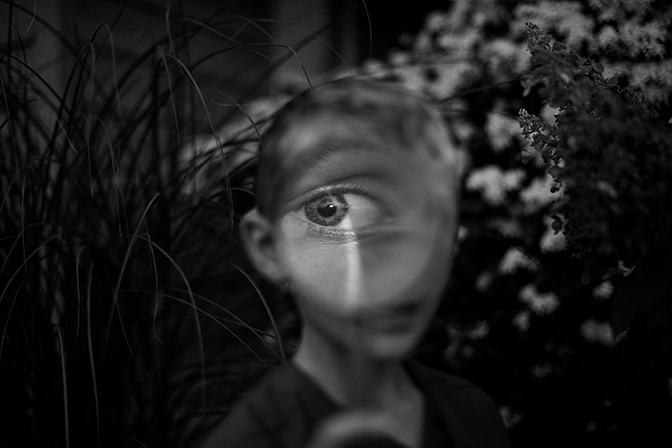
Tytia Habing, I Spy, n.d.
JM: You live in a small town in the Midwest, an area you have described as rural. Is this environment conducive to art marking, or do you find it to be a challenge?
TH: It’s both. I couldn’t work anywhere else, because this is home to me and where I find inspiration. If I were to move and live somewhere else, I’m not sure I would be able to do what I do. On the other hand, it’s a little isolating. I have no local peer group, art centers, or anything you would find in a larger town or city. Thank goodness for the internet. You can make any location work now because of it.
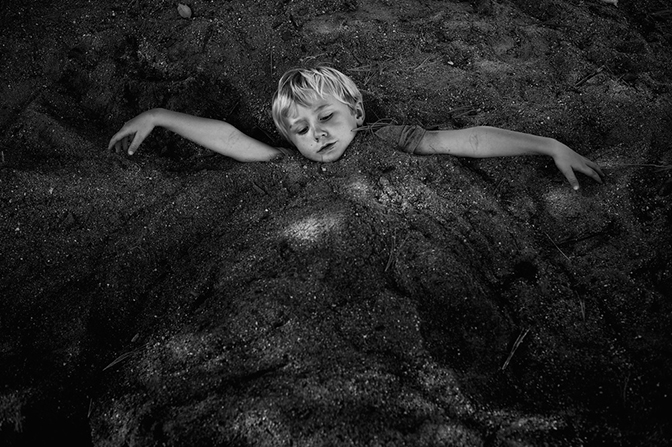
Tytia Habing, Quicksand, n.d.
JM: You mention that you lived in the Cayman Islands. Could you tell us a little about that experience and how, if at all, it affected your work?
TH: It was a wonderful experience and I encourage young people to travel and live abroad if at all possible. I would never change this period of my life, but I lived there for sixteen years and although I had brought my darkroom equipment with me, I genuinely think it stifled my creativity. It wasn’t my home and the images I shot there didn’t have the same feel as the images I shoot here in Illinois. While living there, I would regularly come home for visits and the images I would shoot here at home in Illinois were always so much better than anything I shot in Cayman.
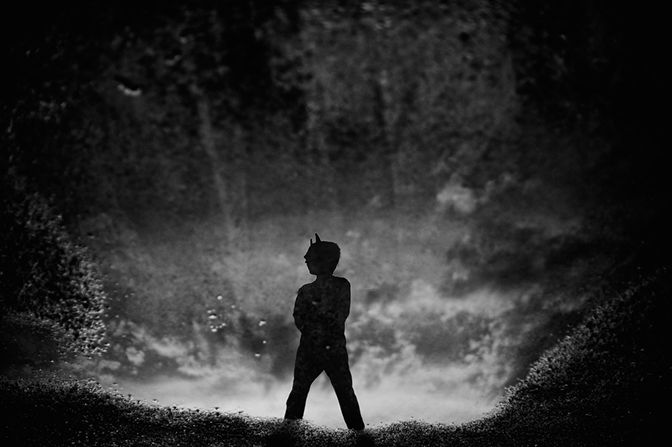
Tytia Habing, Caped Crusader, n.d.
JM: At times I feel that I am viewing a personal family album, while other times I feel like I know your subject personally. I’m quite interested in how you turned the simple, yet personal idea of a “mother taking photos of her child” into an expansive series that speaks to a wide audience – one that is relatable on a much broader scale. Can you expand on this?
TH: To be honest, I never intended my photos to be anything more than a mother taking photos of her child. When my husband and I decided to move back to the US from Cayman six years ago, it was for practical reasons. We wanted to be near family, the price of living was getting out of control in Cayman and crime was becoming a problem there as well. Our plan was for me to become a family/wedding photographer upon moving back. I had no aspirations of anything more than that. It didn’t occur to me until about a year after being back in Illinois that I had something more, and even then I didn’t really see it until others pointed it out to me. It seems ridiculous to say, but it’s true. Once I realized I had something more than family photos, I started shooting with intention. I’m not sure I’m answering the question, but I guess it just kind of happened. I was sharing my personal images on Facebook and I would get comments and emails from my parent’s generation and my generation saying how happy it made them to see my images. It made them feel nostalgic for their past and a little sad that their children and grandchildren didn’t get to experience the same lifestyle and freedoms they experienced as children.
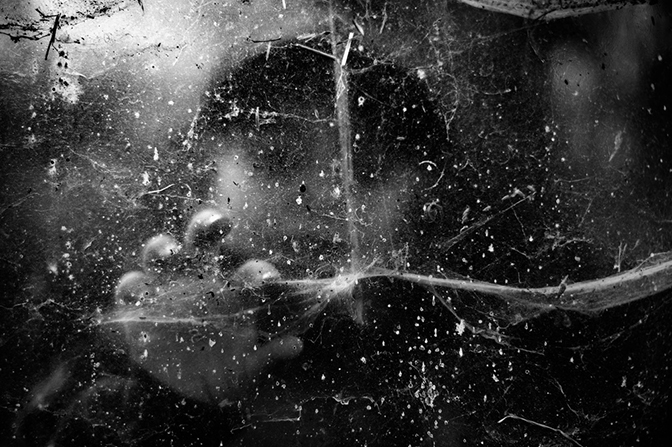
Tytia Habing, Cosmos, n.d.
JM: As a viewer, I see a deep and intimate connection between you and your subject, your son. I also feel that there is a connection between you and your space. How has space and landscape influenced your work and you as an artist?
TH: The landscape has everything to do with my work. It’s an integral part of what I do and I firmly believe if I hadn’t moved back home, I wouldn’t be doing photography the way I do now. I have a great love for where I’m from, the actual land; the soil, the plants and trees, the creatures, all of it. My dad is a farmer, my mom is an amazing gardener and they both instilled a love for the earth in me. I attempt to show that love and intimacy through my photography.
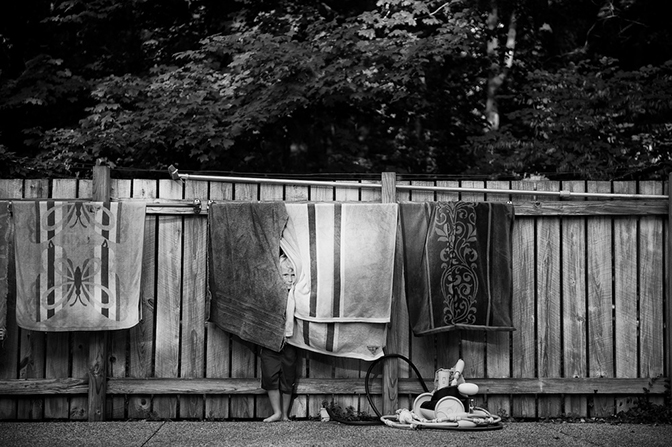
Tytia Habing, Peek, n.d.
JM: There is honesty to your work, a level of unabridged truth. Typically we like to classify photographers (and artists, in general). As a viewer, I find myself wondering if the scenes have been staged or are the images candid. Do you consider yourself a portrait photographer, documentary photographer or something in between? Do you believe the artist’s intent affects the viewer perception of the work?
TH: It’s funny you ask this question, because I’ve always struggled to categorize myself. I’m not really sure where I belong or if it’s even necessary to put myself or anyone into a group. I’ve never liked the idea of lumping people into this or that group. Even as a child I didn’t like it, and as an adult, I like it even less. I understand the reasoning, but I still don’t like it. Having said that, if I had to, I’d call myself a fine art documentary and portrait photographer. Fine art photographer is yet another term I’m not completely comfortable with, but I won’t go there right now.
My images are mostly candid, and I only say mostly because at times, I’ll have him repeat something he’s already done if I’ve missed the shot. I will sometimes ask him to do this or that, but those shots never, ever make it into my projects. It’s always the outtakes. Things he’s done on his own that are much better than anything I could’ve set up or imagined. Staging images simply doesn’t work with my son. The photograph always feels forced like that. You can feel the insincerity in them. I definitely set up the environment in hopes of getting a good shot. For instance, I’ll take him to play at the river in the late afternoon when the light is beautiful, and I’ll ‘suggest’ he play right where the light is falling. It doesn’t necessarily always work, but it can’t hurt to try.
I definitely think the artist’s intent affects the viewer’s perception. That’s the whole reason for the dreaded artist statement. I think every photographer I know has a serious love hate relationship with the artist statement. While the artist’s intent is certainly important, I think the viewers should also be able to form their own opinions of the work. I always view work first, then I read the artist statement. Sometimes it makes the work better in my eyes and sometimes it has the opposite affect.
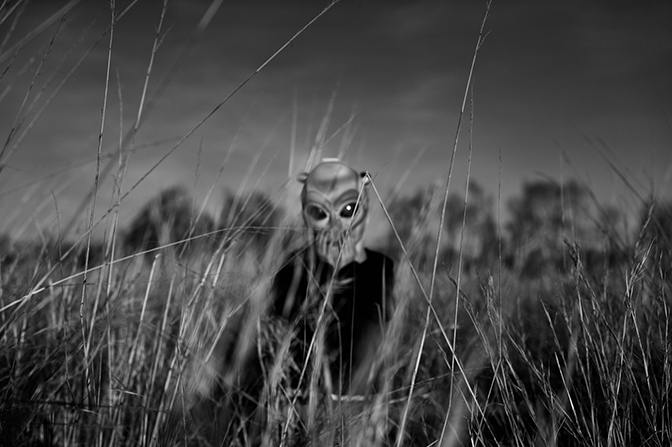
Tytia Habing, One of Many, n.d.
JM: When I first viewed your images on LENSRATCH, I immediately felt a sense of nostalgia. I thought of Pictorialist photographers such as Juliet Margaret Cameron – perhaps because of the application of the images. But in reality, I believe your work is a mix of Ralph Eugene Meatyard and Sally Mann with a side of Timothy Archibald. Can you talk to us about your photographic influences, if any?
TH: When I first started photographing in 1998 I didn’t even know who any famous photographers were, and quite honestly, I didn’t care. I just enjoyed photographing and that’s as far as it went for me. I was like that for many years, so I formed my own style without interference. That’s not to say how I shoot is unique, but it’s how I naturally decided to compose my images without outside influence. I’ve gotten critiques from several people in the photography business that tell me I shouldn’t center my subjects so often, but it’s how I like to shoot. I’m completely aware that I do it, but I like the way it looks, so I’ll continue to photograph that way. That’s not to say I don’t respect their opinions though. I will always listen to suggestions, but I may not necessarily take them.
Years after I first started photographing I had a roommate in Cayman that was also a photographer and he came back from a trip with a gift for me. It was Sally Mann’s book Immediate Family, and I was blown away at how beautiful her photographs were. I’ve been a huge fan ever since, but I think everyone is a fan of hers aren’t they? I’m Facebook friends with Timothy Archibald, so I had to message him this question with a big smiley face attached. I think he’s great. Being compared to any of the above photographers is a huge compliment.
I genuinely try not to be too influenced by what others do, because it’s easy to lose your own creative voice that way. There are so many talented photographers. I could name hundreds of them. A few I really love are Emmet Gowin, Julie Blackmon, Aline Smithson, Cig Harvey, Keith Carter, and Heather Evans Smith…..and that’s just the tip of the infinite iceberg of talented photographers.
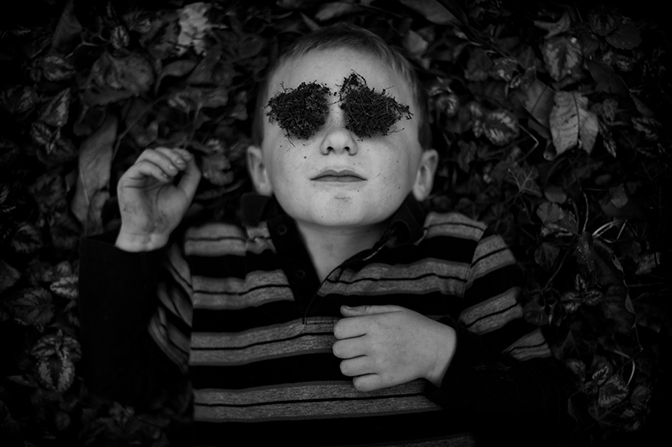
Tytia Habing, Moss for the Ferryman, n.d.
JM: Other than photographers, what else inspires you?
TH: I’m inspired by such diverse things: my family, friends, the land, nature, books, music, oh how I love music, animals, scientists like Neil deGrasse Tyson and Stephen Hawking, innovators like Elon Musk and Richard Branson, painters, movies, everyday people doing everyday jobs….I think everything inspires me! The whole idea of the ‘tortured artist’ doesn’t hold true for me. I have to be happy and inspired to work. If I’m feeling down or in a bad mood, I may as well go back to bed, because I’m not going to get anything done.
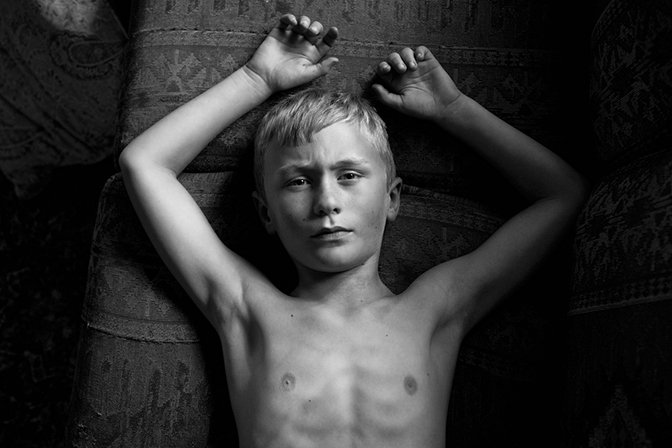
Tytia Habing, Him, n.d.
JM: It is apparent that family is a central part of your work. Do you find it difficult or easy to balance the demands of family and work?
TH: I think balancing family and work is hard for everyone, regardless of their job. Last year I was finally able to move my workspace out of my house, so that’s helped a little. I’m at least not working on the computer at all hours anymore. It’s a work in progress and probably always will be.
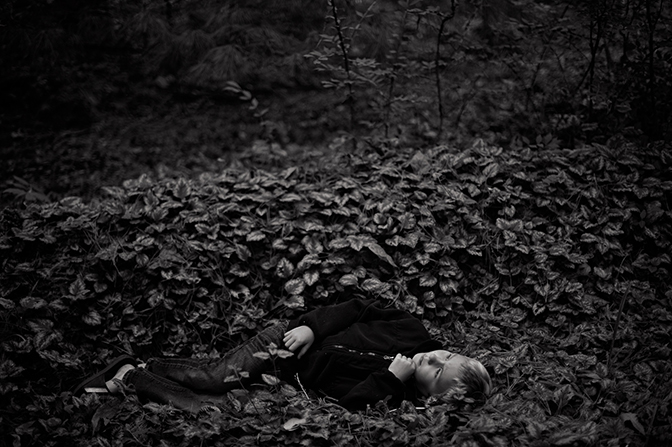
Tytia Habing, In Response, n.d.
JM: You’ve had some exciting publications and exhibitions this year. You’ve been published in Shots Magazine, Fraction Magazine, Lenscratch and National Geographic. BLACK & WHITE Magazine awarded you with the 2016 Portfolio Spotlight Winner award. You’ve had two solo shows this year. What’s next for you?
TH: Oh I wish I knew! Things seem to pop up unexpectedly most times. I was recently commissioned to shoot a spread in Kid’s Wear Magazine out of Germany. I honestly hadn’t heard of it before but it’s quite an amazing magazine with a who’s who roster of photographers that have contributed to it. To say I feel terribly lucky to be asked is an understatement. They shipped over a box of designer clothes from Italy for my son and I shot whatever and however I wanted. It was a dream job and I hope to get more jobs like that in the future. It’ll be out in January.
As far as new projects I’ve had several ideas that interest me floating around in my head for the past couple years. The subjects include space, our food source, how we treat the earth and spirituality. I have no idea which subject I’ll end up going with. Maybe I’ll do all of them or maybe I’ll get a completely different idea to go with. I’ll of course continue photographing my son and family. I’m not sure I’ll ever stop doing that.
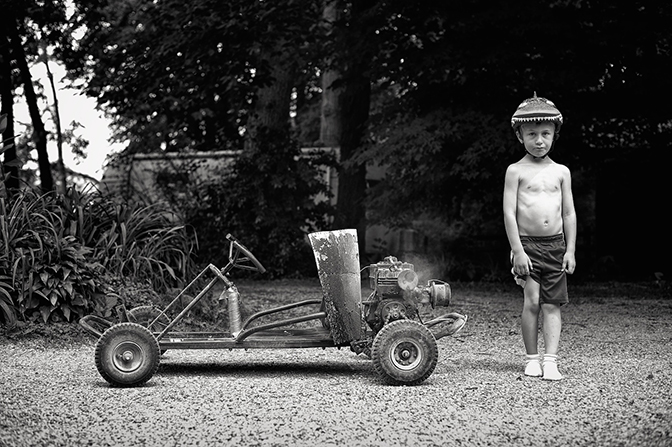
Tytia Habing, Go, n.d.
Tytia Habing lives and works in Watson, Illinois very near where she grew up on a working farm. Having spent most of her adult life living in the Cayman Islands, she moved back to her roots a few short years ago. She holds degrees in both horticulture and landscape architecture and is a self taught photographer. Tytia’s work has been exhibited internationally and has been published in Lenscratch, Black + White Magazine, The Sun, Shots Magazine and National Geographic to name but a few. Most notably, her work has been featured on CNN and shortlisted for both the Black and White Photographer of the Year 2015 sponsored by Leica and Critical Mass 2015.
For additional informormation, please contact Jennifer Moore, Gallery Director at jmoore@stfrancis.edu


